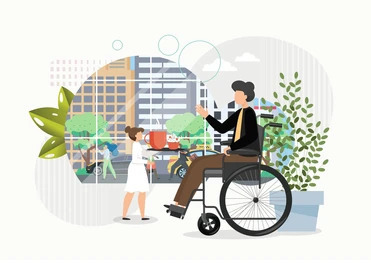
Analysing ‘Accessibility’ in the Latest Draft National Policy for Persons with Disabilities
Strong on intent, weak in implementation
The Draft National Policy for Persons with Disabilities (policy) was released by the Department of Empowerment of Persons with Disabilities (Divyangjan) last month, under the aegis of the Ministry of Social Justice and Empowerment. It identifies various areas for intervention, such as, early identification and prevention, education, skill development, social security, disaster management, among others, to enable persons with disabilities to participate fully and effectively in society.
The policy, currently open to public feedback, reflects India’s extensive commitments under the United Nations Convention on the Rights of Persons with Disabilities as well as the mandate under the Rights of Persons with Disabilities Act, 2016 (RPWDA) enacted subsequently.
A key area identified for intervention is ‘accessibility’, which is a precondition for enjoying the rights guaranteed to persons with disabilities, such as, health, education, employment, justice, community life, sports and recreation, etc.
The policy lays down the specific commitments of the Indian government to secure accessibility to built environment, transportation, information and communication systems (ICTs), and other facilities and services.
Step forward from the 2006 policy
Focus on compliance with detailed accessibility standards – Compared to its predecessor issued in 2006, this policy is far more exhaustive. While the 2006 policy refers to limited accessibility measures, this policy reiterates strict compliance with the detailed accessibility standards notified under the RPWDA for public buildings, transportation systems and ICTs, to make public spaces accessible to persons with disabilities.
Universal design as a guiding principle – The policy also makes a distinctly progressive move by introducing ‘universal design’ as a key guiding principle towards making public spaces accessible to all, and not just to persons with disabilities. Towards a gradual realisation of this goal, it encourages academic curricula at schools and universities to include accessibility and universal design principles for better understanding and adoption in public infrastructure.
Recognising disability as a cross-cutting issue – Where government departments often tend to work in silos, the policy recognises disability as a cross-cutting issue requiring coordinated action. It identifies and places clear commitments on other ministries and departments, such as, the Ministry of Information and Broadcasting, the Telecom Regulatory Authority of India and the Ministry of Road Transport and Highways for issuing accessibility guidelines specific to subject matters within their purview. This could include broadcasting programmes to telecommunications as well as to personal vehicles of persons with disabilities for instance.
What the policy fails to account for
Implementation must match intentions – Despite an accessibility framework in place, public spaces in India continue to remain inaccessible. The policy attempts to address this implementation gap by requiring accessibility standards to be reflected in municipal building bye-laws and complied with at the stage of planning.
However, this is not sufficient. To ensure effective implementation, the policy must mandate ongoing audit or periodic inspection of public infrastructure by persons with disabilities or disabled people’s organisations to ascertain whether accessibility standards are indeed being met or maintained.
The missing element of procurement – Procurement, whether for construction, transport facilities or ICTs, forms an integral component of implementation of accessibility norms. This is conspicuously missing in the policy. Inclusion of accessibility as well as universal design criteria in state and local procurement laws and policies must be included in the policy towards building accessible spaces. Preference in procurement should also be given to persons with disabilities or organisations employing such persons.
Participation of persons with disabilities in planning – While the policy recognises the significance of participation of persons with disabilities in decision making for better planning and monitoring, it does not lay down any definitive framework for doing so. Towards this, town planning bodies at state and municipal levels must ensure participation of persons with disabilities, especially women with disabilities, in the planning process to account for their requirements.
Overall, while the policy is comprehensive, the commitments set out in it can only be realised through awareness, sensitisation and capacity building at all levels, including stakeholders in the government, service providers, private persons involved in implementation at the local level, to better understand the needs of PWDs and build a culture of accessibility and inclusion in the country.
The recommendations mentioned above are analysed in greater detail in Vidhi’s white paper – ‘Beyond Reasonable Accommodation’.
